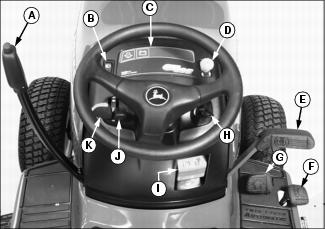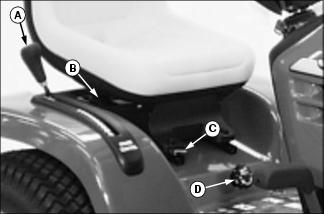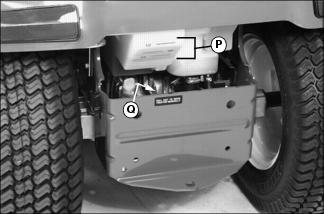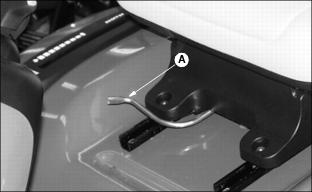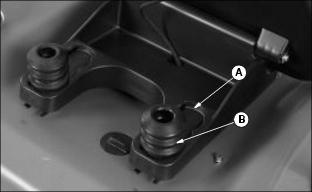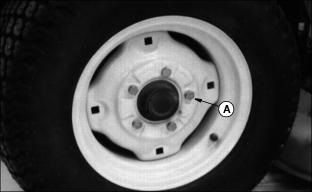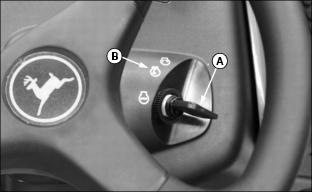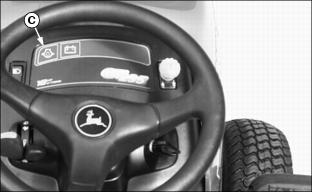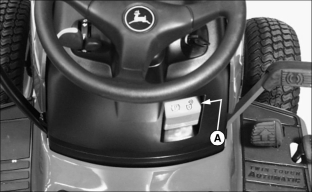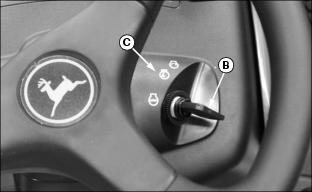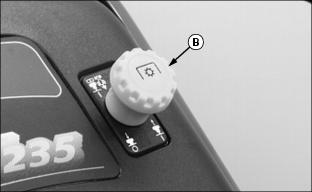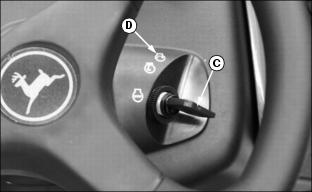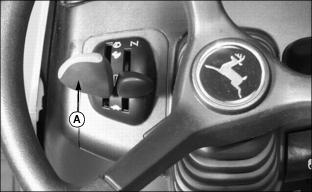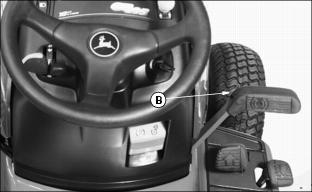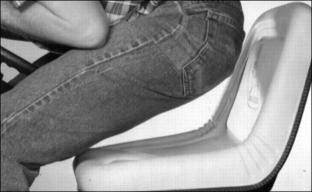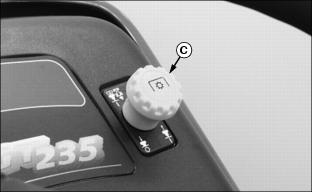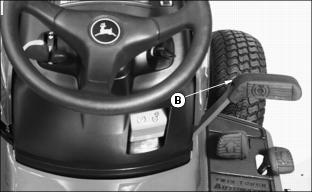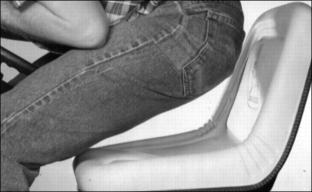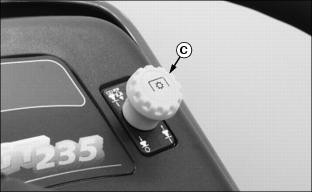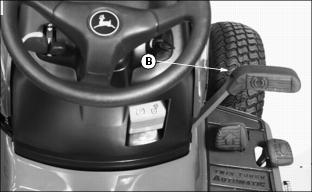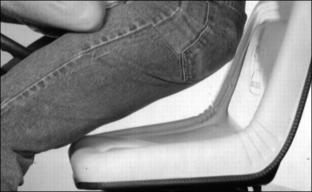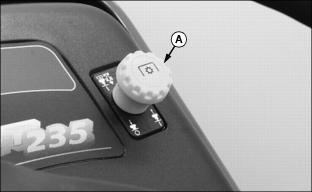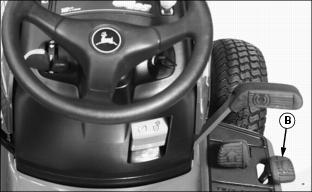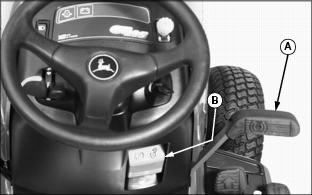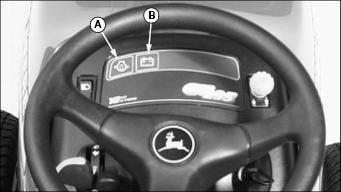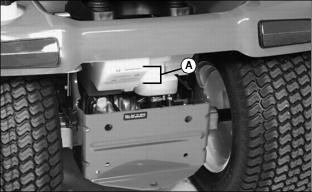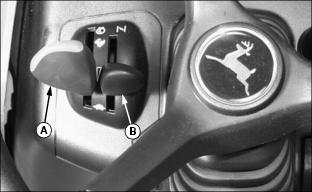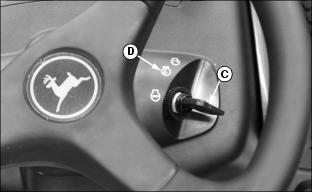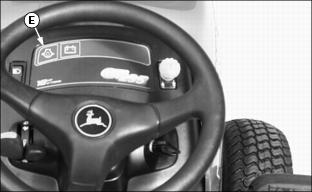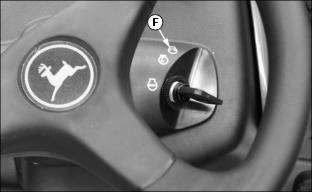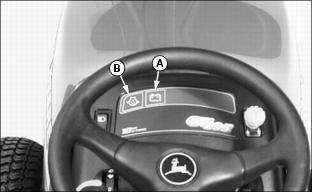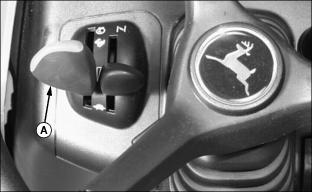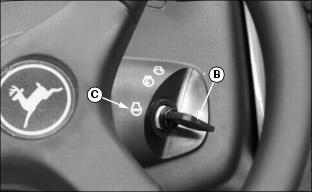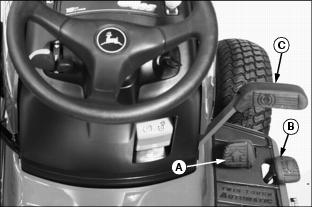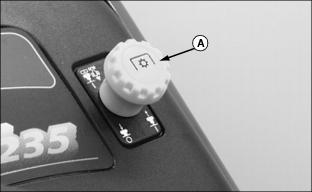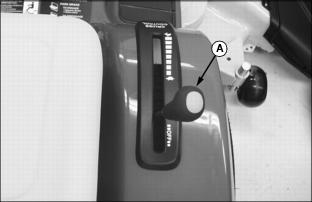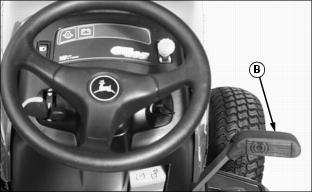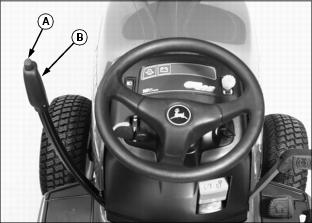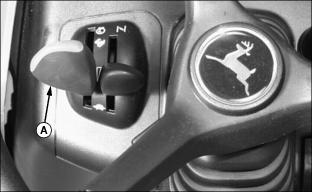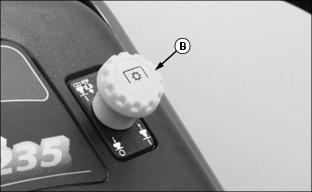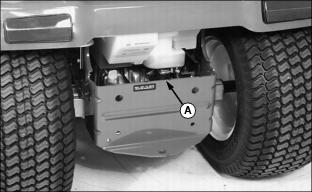Introduction
Product Identification
Safety
Operating
Using The Reverse Implement Option
Using Transmission Free-Wheeling Lever
Transporting Machine on Trailer
Replacement Parts
Service Intervals
Service Lubrication
Service Engine
Service Transmission
Service Electrical
Service Miscellaneous
Troubleshooting
Storage
Assembly
Specifications
Warranty
John Deere Quality Statement
Service Record

Operating
Daily Operating Checklist
o Remove grass and debris from machine.
o Check area below machine for leaks.
Controls
A - Lift lever - Raises and lowers attachments
B - Light switch - Push to engage lights
C - Instrument panel - Indicator lights
D - PTO knob - Engages attachments
E - Brake pedal - Stops machine
F - Reverse travel pedal - Starts reverse travel
G - Forward travel pedal - Starts forward travel
I - Park brake lever - Engages park brake
J - Choke lever - Controls fuel for starting engine
K - Throttle lever - Controls engine speed
A - Cruise control lever - Sets cruise control
B - Seat suspension - Adjusts suspension for operator weight
C - Seat lever - Locks seat in different positions
D - Mower depth control - Sets mowing height
A - Fuel gauge - Indicates amount of fuel in tank
B - Free wheeling lever - Allows tractor to be moved manually
Adjusting Seat
To adjust seat position:
1. Push lever (A) to the left.
2. Slide seat forward or rearward to desired position.
To adjust seat for ride comfort:
Lift seat, unscrew and move springs to desired position as follows:
· Install both springs into front position (A) for softest ride.
· Install both springs into rear position (B) for firm ride.
· Install springs in all four positions (A and B) for the firmest ride. (Order additional springs from your John Deere dealer.)
Adjusting Rear Wheel Spacing
NOTE: · Tractors equipped the bar tires should always have tires mounted with TRACTION ARROW pointing towards the front of tractor.
· Tractors equipped with 48C Mower Decks: Due to rear tire and left rear gage wheel bracket interference, the rear wheels cannot be put into the wide position.
1. Park tractor on a level surface.
2. STOP engine and LOCK park brake.
3. Put blocks in front and back of front wheels.
4. Loosen five rear wheel bolts (A). Lift rear wheels off the ground with floor jack or hoist.
6. Reverse wheels to change spacing:
· Narrow Position: Install wheel with valve stem on the outside. Overall tire width will be approximately 990 mm (39 in.).
· Wide Position: Install wheel with valve stem on the inside. Overall tire width will be approximately 1060 mm (41.7 in.).
7. Tighten wheel bolts to 88 N·m (65 lb-ft.).
8. Lower rear wheels to the ground. Remove blocks from front wheels.
Testing Safety Systems
Service Interval: Check the safety system every 50 hours of operation.
Use the following checkout procedure to check for normal operation of tractor.
If there is a malfunction during one of these procedures, DO NOT operate tractor. (See your John Deere dealer for service.)
Perform these tests in a clear open area. Keep bystanders away.
Test 1
Check operation of indicator lights:
1. Turn key (A) to RUN position (B).
2. LOOK: Indicator light (C) must light.
· If indicator does not light, see Replacing Indicator Light Bulb in Service-Electrical section.
· If new indicator bulb does not light, see your John Deere dealer.
Test 2
Test brake switch:
1. Unlock park brake (A). Release lever and brake pedal.
2. Turn key (B) to START position (C).
Test 3
Test PTO switch:
1. Depress brake pedal (A), or lock park brake.
3. Turn key (C) to START position (D).
Test 4
Test seat switch:
b. Move throttle lever (A) up to MAXIMUM engine speed.
c. Unlock park brake and release brake pedal (B).
e. Raise up off seat. DO NOT get off tractor.
f. After an approximate 1/2 second delay, engine should begin to die and PTO should shut off (mower blades should stop).
c. UNLOCK park brake and release brake pedal (B).
d. Raise up off seat. DO NOT get off tractor.
e. After an approximate 1/2 second delay, engine should begin to die.
d. Raise up off seat. DO NOT get off tractor.
e. Engine should continue to run.
Test 5
Before moving rearward, make sure area is clear of bystanders, especially children. |
Test Reverse Implement Option:
2. Engage PTO (A) to start attachment.
3. Look behind the vehicle to be sure there are no bystanders.
4. Begin REVERSE travel by depressing REVERSE foot pedal (B).
5. Attachment should stop operation. If attachment continues to operate while tractor travels in REVERSE, do not continue to operate attachment. See your John Deere dealer for service.
Using Park Brake
LOCK PARKING BRAKE:
1. Push and hold brake pedal (A) all the way down.
2. Pull park brake lever (B) up to LOCK park brake.
3. Release pedal and park brake lever. Pedal should stay down and park brake lever should stay up in LOCKED position.
IMPORTANT: Avoid damage! To avoid transmission damage, be sure to UNLOCK park brake before using travel pedals. |
UNLOCK PARKING BRAKE:
1. Push and hold brake pedal (A) all the way down.
2. Push park brake lever (B) down.
3. Release pedal. Pedal should come up to operating position.
Indicator Lights
A - Oil Pressure Indicator Light - will come on when you turn the key to the RUN position. Indicator should go out when engine is started. If indicator comes on during operation, engine oil pressure is too low. Stop engine and perform appropriate service.
B - Battery Discharge Indicator Light - will come on when battery voltage falls below 12.3 volts. Indicator light will be on during start-up. Indicator light may also remain on at low idle. If battery is at a low state of charge, indicator light may remain on if PTO and headlights are on.
Using Fuel Gauge
Locate fuel tank at rear of tractor.
Fuel level can be determined by indicator lines (A) that are molded into tank.
Starting the Engine
NOTE: You must hold brake pedal down, or LOCK park brake, before you can start the engine. PTO switch must be off.
1. Either LOCK park brake or depress brake pedal.
2. If engine is warm, leave throttle lever (A) at SLOW position.
NOTE: · Choke lever is spring assisted. Push lever to the CHOKE position when starting. Release lever after engine starts and return to no-choke position.
· Choking may not be necessary when starting a warm engine.
3. Push and hold choke lever (B) all the way up to the CHOKE position.
4. Turn key (C) to the RUN position (D).
· Oil Pressure indicator (E) will come ON.
5. Turn key to the START position (F):
· If engine does not start within 5 seconds, turn key to STOP position and wait 10 seconds.
· Crank engine again for 5 seconds.
Repeat this procedure if necessary.
6. As soon as engine starts, release key. The key will return to the RUN position and all indicator lights should be off. If a light does not go off, stop engine and perform appropriate service. Release choke lever and put throttle lever in the appropriate position.
Cold Weather Starting
NOTE: This crank procedure will improve starting and will reduce the chance of flooding and muffler backfire.
1. Put throttle lever at mid-throttle position.
2. Push choke lever all the way up to CHOKE position.
3. Turn key to START position to crank engine:
· If engine does not start, wait 10 seconds.
· Crank engine again for 5 seconds.
· Repeat this procedure if necessary.
4. When engine starts, release key to RUN position.
5. May need to choke engine periodically during first few minutes of running.
Checking Indicator Lamps
After engine starts:
NOTE: Tractors are equipped with a battery discharge light (A), and an engine oil pressure light (B).
· Oil pressure light (B) should go out within 5 seconds.
· Battery discharge light (A) should go out within 10 seconds. If not, move throttle lever to 3/4 position.
· If indicator lights stay on longer than given time, stop engine. Find and correct problem.
Stopping the Engine
2. Pull throttle lever (A) down to the SLOW position. Let engine reach low idle speed for a few seconds.
3. Turn key (B) to STOP (Off) position (C).
4. LOCK park brake. Remove key.
Using Travel Controls
· Before moving forward or rearward, make sure area is clear of bystanders, especially children. |
TO TRAVEL FORWARD:
· Slowly push down forward pedal (A). Tractor will travel faster the farther down you push the pedal.
· Release forward pedal, tractor will automatically return to NEUTRAL and STOP.
TO TRAVEL IN REVERSE:
1. Bring the vehicle to a stop.
2. Push PTO knob down to the OFF position to disengage attachment.
3. Look behind the vehicle to be sure there are no bystanders nearby.
NOTE: Any operating attachment will stop as the REVERSE foot pedal is depressed with attachment engaged.
FOR EMERGENCY STOPPING:
· Release either travel pedal, tractor will automatically return to neutral and STOP.
· Push down on brake pedal (C). Tractor brakes will be applied to assist in stopping.
Using The Reverse Implement Option
· Before moving forward or rearward, make sure area is clear of bystanders, especially children. |
NOTE: Operating the mower while backing up is strongly discouraged. The Reverse Implement Option should be used ONLY when operating another attachment or when the operator deems it necessary to reposition the machine with the mower engaged.
1. Stop the machine FORWARD travel with attachment engaged.
2. Look behind the vehicle to be sure there are no bystanders.
NOTE: If the attachment stops while repositioning the machine, return PTO knob to the OFF position. Begin again with Step 2 in procedure.
3. Lift and hold the PTO knob (A) up past the PTO engagement position to activate the reverse implement position while depressing REVERSE foot pedal slightly.
4. As the machine begins to move backward, release the PTO knob and reposition the machine.
5. Resume FORWARD travel. The attachment should continue operating.
6. Repeat Steps 1 through 5 to reposition the machine again.
Using Cruise Control
Operate tractor in a large, open area to learn how the cruise control works. |
Use cruise control when you want to maintain travel speed without having to hold the forward travel pedal down. Cruise control operates only for forward travel.
ENGAGE CRUISE CONTROL:
1. Start with the cruise control lever (A) in the OFF position.
2. Move cruise control lever forward, at the position the tractor will begin to move forward.
3. Continue to move cruise control lever forward toward the position and the tractor will increase in speed.
4. Move cruise control lever to the desired speed and release lever.
DISENGAGE CRUISE CONTROL:
NOTE: Depressing brake pedal (B) will return cruise control lever to the OFF position.
1. Move the cruise control lever to the OFF position.
Using Lift Lever
Check out the three different lift lever positions before operation:
· UPPER "TRANSPORT" POSITION: Raises mower for transport.
· MIDDLE "FLOAT" POSITION: Mower should drop to desired cutting height by itself. UNDER NORMAL CONDITIONS, MOW WITH LEVER IN MIDDLE POSITION.
· LOWER "LOCK-OUT" POSITION: Locks out lift assist spring. Use when mowing in rough terrain to prevent mower from inadvertently latching into transport position.
1. When lever (B) is in middle FLOAT position:
· Lift mower to TRANSPORT position by pulling lever all the way back until it clicks.
· Lower mower to LOCK-OUT position by pushing lever forward until it clicks.
2. To take mower out of TRANSPORT position:
· Pull lever (B) back slightly.
3. To take mower out of LOCK-OUT position:
· Push down on lever (B) slightly.
· Pull lever back towards you.
Lift lever is also used to raise and lower other attachments such as a snowthrower or blade. (Refer to attachment operator manual for instructions on how to use lever with attachment.)
Using PTO (Power Take-Off)
To ENGAGE PT:
2. Reduce travel speed or stop travel.
3. If engine has not been running, allow engine to warm 2-3 minutes.
4. Push throttle lever (A) all the way up to maximum engine speed position.
5. The PTO switch (B) is a three position switch:
· Position " - Use this position to engage the PTO before the tractor is in reverse. To engage this position, lift switch lever fully. (See Using The Reverse Implement Option in this section.)
· Position "I" - Use this position to engage the PTO. To engage the PTO pull up on switch lever.
· Position "O" -Use this position to disengage the PTO. To disengage the PTO push down on switch lever.
NOTE: Always operate engine at maximum speed when PTO is engaged.
To DISENGAGE PTO:
· Push PTO switch lever (B) down to position "O", this will disengage the PTO.
Using Headlights
· The headlight switch (A) is a two-position rocker type switch:
· Push the down to turn lights on.
· Push the other end down to turn lights off.
Using Transmission Free-Wheeling Lever
IMPORTANT: Avoid damage! Avoid transmission damage: · Only push tractor by hand, do not use another vehicle to push tractor. |
When you need to move the tractor by hand without starting the engine, use the transmission free-wheeling lever:
NOTE: The park brake must be unlocked before you can pull out the free-wheeling lever.
2. Pull free-wheeling control lever (A) rearward until it clicks.
3. Push tractor to desired location.
Lever will automatically return to the operating position when you push down the brake pedal.
Using Weights
Install tractor front weights to improve stability when operating on slopes.
See your John Deere dealer for the correct weights. Follow instructions provided with weights to install on your machine.
Using Rear Weights
The rear hitch plate (A) holds four suitcase weights. Use of these weights is recommended when a front attachment, such as snowthrower or blade is used. (See your John Deere dealer for weights.)
Using Tire Chains
Tire chains are recommended for use with snowthrower and, under certain conditions, the front blade. (See your John Deere dealer for tire chains.)
Transporting Machine on Trailer
Be sure trailer has all the necessary lights and signs required by law.
IMPORTANT: Avoid damage! Transmission damage may occur if the machine is moved or towed incorrectly: |
1. Drive forward onto heavy-duty trailer.
2. Lower mower to trailer deck.
4. Fasten lawn tractor to trailer with heavy-duty straps, chains, or cables. Both front and rear straps must be directed down and outward from tractor.
Mowing Tips
The following recommendations will produce the best lawn cut quality and appearance:
· Keep mower blades sharp. Dull blades will tear grass; tips of grass will then turn brown.
· Cutting grass too short may kill grass and let weeds grow easily.
· Adjust cutting height to remove only 1/3 of the grass at a time.
· Mow grass often. Short grass clippings will decay quickly.
· Mow with engine at full throttle.
· Adjust travel speed to match mowing conditions:
· Travel at SLOW speed when you mow thick, tall grass, make sharp turns or trim around objects.
· Travel at MODERATE speed when you mow thin grass.
· Use a different mowing pattern each time you mow. Overlap mowing paths 50 to 100 mm (2 to 4 in).
· Drive over ridges and through shallow ditches straight-on, not at an angle.
· A thick layer of mulched leave can prevent sunlight from getting to grass and smother it. Taller grass heights allow mulched leaves to dispense easier in lawn. Mulch leaves several times if needed.
· Use a thatcher in late spring or summer to pull up dead grass and aerate ground.

